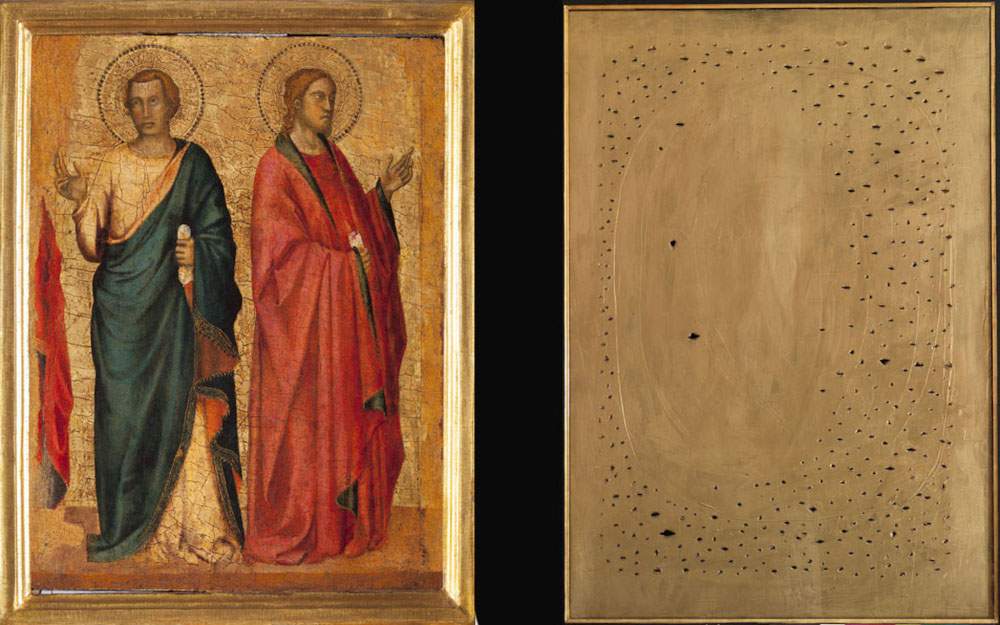From Nov. 24, 2023, to March 3, 2024, MAN in Nuoro presents the previously unseen exhibition GIOTTO | FONTANA. The Golden Space, curated by Chiara Gatti, in collaboration with Mart in Rovereto and Fondazione Giorgio Cini in Venice. The exhibition aims to investigate the nexus that, centuries apart, links Lucio Fontana ’s spatial research with the value of space in Giotto’s compositions, together with the highly symbolic presence of the color gold in its reification of the infinite and elsewhere.
A new sense of reality and space emerges thanks to the personality of Giotto (Florence?, c. 1267 - Florence, 1337), whom contemporaries were already praising because he “remutated the art of painting from Greek into Latin,” as Cennino Cennini wrote about Giotto’s art. The sacred and golden space, two-dimensional and transcendent, a curtain of light that isolates from the outside world of the earlier tradition, is “pierced” by Giotto, in search of a third dimension, deep and real. The gold background becomes real, atmospheric sky, bright and clear on spring days, illuminated by moonlight and stars in the dark night. Giotto discovers how painting can depict what the eye sees, including the possibility of illusion, wonderfully first experimented with in the two famous fake choruses in the Scrovegni Chapel in Padua. Here, in the early fourteenth century, even before the invention of Renaissance perspective, Giotto introduced the idea of trompe-l’oeil, of painting capable of transforming space and creating illusionistic environments. A space without figures and in which the outside world bursts in.
But even in the gold backgrounds, one thinks of the youthful Madonna of Borgo San Lorenzo and that of San Giorgio alla Costa or the later Majesty of All Saints, the metaphysical sky is no longer infinite and, at the same time undefined, but physical and real. The figures are as robust as sculptures and in the background, albeit golden, air circulates. Contributing to the introduction of reality into the painting is the use of light, of which Giotto always identifies the source, which shapes volumes, occupies space making it plausible and ’natural’. Contributing are the insights with which the master grasps the relationships between light and color, his unprecedented approach to the everydayness of life, in the curious rendering of expressions, objects, and nature, as a lens thrown wide open again on reality, in all its aspects, from the most sacred to the humblest, reproposed in the truth of architectural and landscape spaces. Precisely in this reappropriation of reality, beyond the patterns of tradition, life, space, man and his feelings once again become the protagonists of painting.
A lively and revolutionary approach current even for modern and contemporary painting, which owes so much debt to his thought. “The fundamental conditions in modern art are clearly evident in the 13th century, in which the representation of space begins,” wrote Lucio Fontana in his 1946 Manifiesto Blanco. With Fontana, Giotto’s new and illusory space is in fact transformed into a truly three-dimensional space. The light that passes through it makes palpable the principle of the threshold, the overlook, the boundary place between visible and invisible, according to the ancient concept of iconostasis that Fontana reinterprets in the radical synthesis of his gesture. Light thus breaks into a mental space, making it suddenly passable. It is precisely the same light that, in the gold backgrounds of the fourteenth century, as analyzed between the pages of Pavel Florensky’s The Royal Doors, saw a materialization of the immaterial and that then crossed Lucio Fontana’s Spatial Concepts, caressing sands, stones, pieces of glass and gold leaves. A rampant and warm light, but generated by a pictorial act.
The dialogue proposed in the exhibition between a precious panel by Giotto, namely the Two Apostles from the Giorgio Cini Foundation in Venice, and a Spatial Concept by Lucio Fontana from the MART in Rovereto, draws not only on Florensky’s speculations, but also on a long literature focused on the courses and recourses of that magnificent obsession of painting for the representation of the absolute, scientifically addressed by great scholars. A tension toward the infinite and transcendent unites ancients and contemporaries and makes the dialogue between Giotto and Fontana significant and timely in the sense of an exemplifying lunge, minimalist as much as intense, between the folds of this theme of universal art study. Icon painting presupposes a metaphysics of images and light that finds sensitive heirs in the twentieth century. And it is to this metaphysics that authors such as Wildt, Carrà, Casorati and then Melotti and Fontana, as well as international masters such as Mark Rothko or Yves Klein, have looked, even turning to the use of gold as a vehicle toward the abstract, toward the sacred. “To discover the Cosmos,” Lucio Fontana repeated, “is to discover a new dimension. It is to discover the Infinite. So by piercing this canvas-which is the basis of all painting-I created an infinite dimension.”
The exhibition is produced by the MAN Museum in Nuoro and the scientific texts are by Andrea Nante and Paolo Campiglio, Serena Colombo and Chiara Gatti, with coordination by Rita Moro.
Pictured, left, Giotto (and workshop), Two Apostles (1325-1330; tempera and gold on panel, Venice, Giorgio Cini Foundation); right, Lucio Fontana, Spatial Concept (1960-1961; holes, oil and graffiti on canvas; Rovereto, MART Museum of Modern and Contemporary Art of Trento and Rovereto) © Lucio Fontana Foundation, Milan, by SIAE 2023
 |
| A new exhibition at MAN in Nuoro compares Giotto and Lucio Fontana with the color gold |
Warning: the translation into English of the original Italian article was created using automatic tools. We undertake to review all articles, but we do not guarantee the total absence of inaccuracies in the translation due to the program. You can find the original by clicking on the ITA button. If you find any mistake,please contact us.